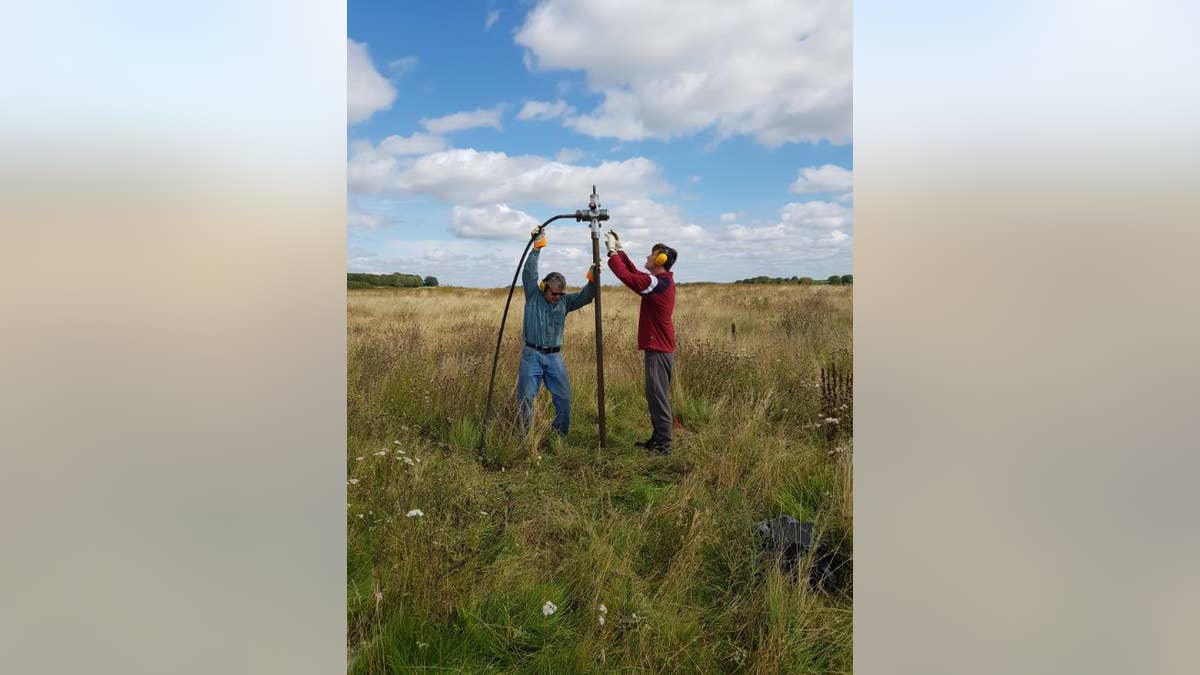Evidence of larger version of Stonehenge discovered
Contained as many as 90 stones standing 15 feet high
Archaeologists have discovered a huge 1.2-mile-wide ring of Neolithic shafts near Stonehenge in southern England.
Experts led by the U.K.’s University of Bradford report that the shafts are up to 32.8 feet wide and 16.4 feet deep. The structures have been carbon-dated to 2500 B.C.
Up to 20 shafts have been identified, but archaeologists think that, originally, there may have been more than 30.
STONEHENGE WAS LIKE ANCIENT 'LEGO,' EXPERTS SAY
The shafts form a ring around the “super henge” at Durrington Walls, a much larger Neolithic monument than Stonehenge. Super henge is located about two miles from Stonehenge and is 15 times larger than its famous counterpart, according to LiveScience.
Woodhenge, a prehistoric monument once composed of six rings of wooden posts enclosed by an earth embankment, is also within the ring formed by the shafts.
“The area around Stonehenge is among the most studied archaeological landscapes on earth and it is remarkable that the application of new technology can still lead to the discovery of such a massive prehistoric structure which, currently, is significantly larger than any comparative prehistoric monument that we know of in Britain, at least,” said Professor Vince Gaffney of the University of Bradford, in a statement.
STONEHENGE MYSTERY SOLVED: MASSIVE ROCKS CAME FROM 180 MILES AWAY
The discovery was made as part of the Stonehenge Hidden Landscape Project. Experts from the Ludwig Boltzmann Institute for Archaeological Prospection and Virtual Archaeology in Austria also participated, as well as the U.K.’s Universities of Birmingham, St Andrews, Warwick, the University of Wales Trinity Saint Davids, and the Scottish Universities Environmental Research Centre at the University of Glasgow.

Experts led by the University of Bradford discovered the underground structures. (University of Bradford)
“When these pits were first noted it was thought they might be natural features – solution hollows in the chalk,” Gaffney added. “Only when the larger picture emerged, through the geophysical surveys undertaken as part of the Stonehenge Hidden Landscape Project, could we join the dots and see there was a pattern on a massive scale.”
The research is published in the journal internet archaeology.
MISSING PIECE OF STONEHENGE RETURNED 60 YEARS AFTER IT WAS REMOVED DURING EXCAVATION
Stonehenge continues to be a source of fascination. Parts of it bear a resemblance to ancient "Lego," according to a recent report by English Heritage, which oversees the famous site in southern England.

Many have speculated over the purpose of Stonehenge. (iStock)
In 2018, experts said that the famous ancient site may have been built using Greek philosopher Pythagoras’ famous theorem two millennia before the mathematical equation was developed.
Last year a missing piece of Stonehenge was returned 60 years after it went missing during an archaeological excavation.
The first monument at the site, an early “henge” monument, was constructed about 5,000 years ago. The world-famous stone circle was built around 2,500 B.C. during the late Neolithic period.
CLICK HERE TO GET THE FOX NEWS APP
The World Heritage site is known for its alignment with the movements of the sun – thousands travel to the site near Amesbury in Southern England to mark the solstices in summer and winter.
Fox News’ Chris Ciaccia and the Associated Press contributed to this article.
Follow James Rogers on Twitter @jamesjrogers





















